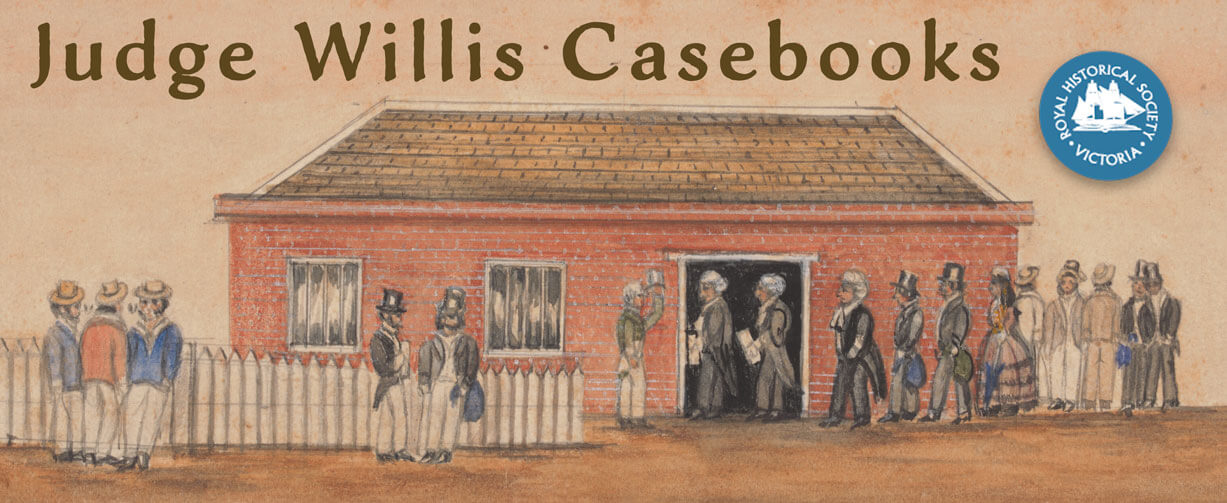
Establishment
On 26 June 1840 the Port Phillip Herald published a list of the ‘wants’ of the settlers of Port Phillip. The first item on their list was a Resident Judge, a registry office, a sheriff, a courthouse and “all the paraphernalia of a Supreme Court”. In March 1841 their wish was granted when Mr Justice Willis arrived, along with several legal officials, to preside over the Supreme Court of New South Wales in the Port Phillip District. Until then, prisoners facing trial in the Supreme Court had to be taken to Sydney. It was an expensive process to ship prisoners and witnesses so far, and delays often occurred while waiting until there were several prisoners awaiting trial to justify the expense.
Status
The Supreme Court at Sydney and the newly-established Supreme Court at Melbourne were both Supreme Courts, with jurisdiction over civil, criminal and admiralty matters. The Port Phillip court issued its own Rules of Court and its own tariff of fees, and it had its own Bar, independent of that in Sydney. However, appeals from the decisions of the single Judge of the Supreme Court of New South Wales Port Phillip were to be heard by the full bench of the Supreme Court of New South Wales in Sydney. This was to lead to a perception that the Port Phillip court was an inferior court, which Justice Willis strenuously resisted. The status of the Sydney and Melbourne courts was identical, but Willis was a single judge, while the Sydney court had a bench of three.
Functions
Judge Willis, as the sole Supreme Court judge in the Port Phillip court, heard all common law, equity and ecclesiastical matters. These were scheduled into the judicial calendar with the court sitting in its criminal jurisdiction on specified days of the month, and its civil jurisdiction on other specified days. Criminal cases were heard before a jury, while civil cases were heard before the judge and two assessors (JPs), with a jury trial permitted at the discretion of the judge.
Jurors
Unless exempted or disqualified, jury service was required of all men aged between 21-60 living within fifty miles of Melbourne in receipt of £30 per annum from real estate, or holding a clear personal estate of £300 in value. The bitter contest over the right of ex-convicts to sit as jurors had largely abated by this time. Men who had been twice convicted of treason, felony or infamous offence were excluded, as were men of bad fame, dishonest life or conduct, or immoral character and repute. Common jurymen were paid 1/9d for every case they heard, and could be fined £5 for non-attendance. Jury panels were summoned alphabetically by surname.
Special juries could be appointed at the discretion of the judge. These were juries composed of men who were “an esquire or person of higher degree”, Merchants (not shopkeepers), Bank Directors, JPs and, after 1842, Town Councillors. They were largely drawn from the mercantile and commercial class and assumed to be better able to assess the complexities of civil and criminal libel trials. They were paid 15 shillings for every case they heard, and fined £10 for non-attendance.
Lower Courts
The Supreme Court stood at the head of a system of lower courts headed by commissioners and justices of the peace. These dealt with summary crimes and misdemeanours not punishable by death, and civil matters involving claims for less than £10, later extended to £30. They included the Court of Requests for civil matters, the Court of Petty Sessions for both criminal and civil matters, and the Court of General and Quarter Sessions, where Judge Willis sat as Chairman alongside two or three other magistrates and a jury. In 1842 the Insolvency Court was established within the Supreme Court, where Judge Willis sat with the Chief Commissioner for Insolvent Estates. The prominence of the Supreme Court in its civil jurisdiction was heightened during the economic depression of 1842-44, most particularly in relation to insolvency and financial impropriety.
In 2014, The Judge Willis Casebooks website was developed with support from the Wilson Trust & His Honour Paul R Mullaly QC. The website was created by Jason Odering. In 2018, the RHSV website was rebuilt and the Judge Willis Casebooks have been reconstructed with respect to the original layout and design. Judge Willis Casebooks: Terms of Use

 239 A'Beckett Street Melbourne, Victoria, 3000
239 A'Beckett Street Melbourne, Victoria, 3000  03 9326 9288
03 9326 9288  office@historyvictoria.org.au
office@historyvictoria.org.au  Office & Library: Weekdays 9am-5pm
Office & Library: Weekdays 9am-5pm

